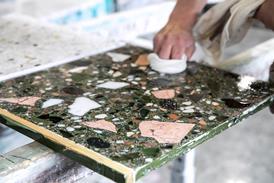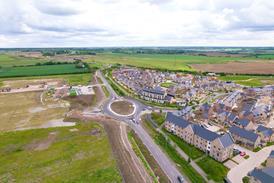The shock findings of this week’s NAO report into botched external wall insulation installations has damaged public confidence in the benefits of retrofit. Decisive action is needed to restore faith and prevent future waste, says Thomas Lane
The National Audit Office report into botched external wall installations deals a body-blow to the benefits of retrofit and the industry’s reputation for quality.
A staggering 98% of external wall installations funded by ECO4, the fourth iteration of the Energy Company Obligation scheme and the Great British Insulation Scheme were found to be substandard.
In the majority of cases there was a risk of water getting behind the external insulation boards thanks to issues such as insufficient coverage of the insulation by the eaves leading to internal damp and mould. Other problems included insufficient ventilation being left for gas boilers, leading to the risks of carbon monoxide poisoning and exposed electricity cables.

This is potentially deadly for those whose installations have been botched and bad for the UK energy billpayer. Between 22,000 and 23,000 homes were affected and, while the report does not separate the specific costs of installing external wall insulation, the Energy Savings Trust estimates this costs £18,000 for an average three-bedroom semi-detached home, a total of some £400m.
The NAO estimates that remediating the problems will cost between £5,000 and £18,000 per installation, adding another £264m (if averaged) to the cost – although the installers are supposed to cover this cost. It is a racing certainty that a net zero-sceptic political party will use this fiasco as evidence of why the UK needs to dump its carbon reduction commitments.
It also feeds into the broken Britain narrative. This is an example of government – in this case the Tories – handing out millions of pounds followed by a press release saying what wonderful work they were doing, then failing to implement the systems necessary to ensure the money is effectively spent.
The industry comes out of this badly. The work was poorly executed thanks to a lack of skills and corner-cutting, with the problem exacerbated by installers subcontracting work to others not registered with the scheme
The NAO criticises the Department for Energy Security and Net Zero (DESNZ) for setting up a scheme with limited oversight as it handed quality assurance to TrustMark, the “government endorsed quality scheme”, and poor risk management with limited senior management attention on ECO.
There were no clearly defined roles and responsibilities between those responsible for the scheme. The report says: ‘Nobody we spoke to could give a comprehensive explanation of how the system was meant to work.”
Unsurprisingly the industry comes out of this badly. The work was poorly executed thanks to a lack of skills and corner-cutting, with the problem exacerbated by installers subcontracting work to others not registered with the scheme.
In the worst cases there is suspected fraud. Ofgem has used TrustMark data to estimate that installers had falsified claims for between 5,600 and 16,500 homes and then fraudulently claimed between £56m and £165m.
Much of the failings of this scheme are down to inadequate auditing of the installers, including insufficient site checks.
The bones of an effective scheme were already in place thanks to PAS 2035 and PAS 2030, the retrofit standards designed to ensure retrofit measures are appropriate for a particular home, with the work done to a high standard. This includes a whole home assessment to determine the condition and type of construction of the home.
Some installers were employing the retrofit assessors and co-ordinators, meaning they were less likely to call out substandard work
A retrofit designer draws up a package of appropriate measures and a retrofit co-ordinator then co-ordinates and manages the work, which is done by a retrofit installer. Installers must be certified as competent; only then can they be TrustMark accredited, which allows them to work on government-funded schemes.
This fiasco has exposed the weaknesses of PAS 2035. The NAO found that some installers were employing the retrofit assessors and co-ordinators, meaning they were less likely to call out substandard work.
Other installers were gaming the system by understating the number of installations to the certification bodies and registering with several to reduce the level of audit. And some installers knew that they could get away with shoddy workmanship knowing their work was unlikely to be checked – and the fact that consumers did not have the technical expertise to identify problems.
TrustMark, for its part, was charging very low fees, which meant that it did not have the systems in place to identify non-compliance trends. This meant the problem went undetected for three years. Nor did it have the resources to employ people qualified to check work against PAS 2035.
>> Also read: FMB renews calls for mandatory licensing scheme in wake of shock NAO report on retrofit scheme failures
The government has a clear duty to put in place measures to ensure this does not happen again on publicly funded retrofit schemes, and to help restore consumer confidence. This is particularly important for owner occupiers funding their own retrofits.
There needs to be clear leadership from ministers to ensure that the right systems are put in place, with senior civil servants taking ownership for the success of these schemes. The roles and responsibilities of the different organisations involved need to be properly defined, including responsibility for scheme administration, monitoring and compliance checking. This should be properly funded by the scheme and include fully independent retrofit assessments of homes and retrofit co-ordination.
As the government is relying on TrustMark for installer quality control on publicly funded schemes, this needs to be properly resourced to ensure that registered firms are indeed competent, are registering with just one certification body and not subcontracting out work to non-registered organisations. And there must be more onsite audits to check that work is being done properly and not subcontracted.
This will cost more, but this debacle shows that failure to act ultimately costs much more – and includes health risks. It is essential to start restoring people’s faith in the construction industry and the benefits of retrofit.



























No comments yet